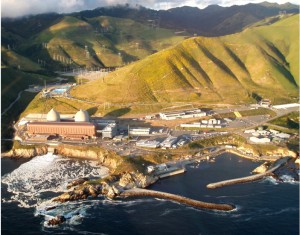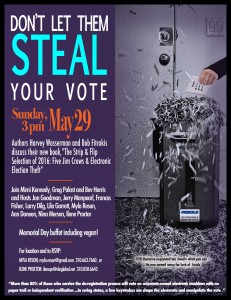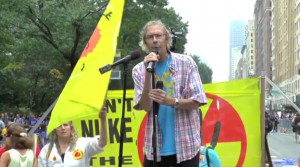NY Times Pushes Nukes While Claiming Renewables Fail to Fight Climate Change
(cross posted at Eco Watch)
The New York Times published an astonishing article last week that blames green power for difficulties countries are facing to mitigate climate change.
The article by Eduardo Porter, How Renewable Energy is Blowing Climate Change Efforts Off Course, serves as a flagship for an on-going attack on the growth of renewables. It is so convoluted and inaccurate that it requires a detailed response.
 Our planet is burning up from fossil fuels and being irradiated by decrepit money-losing reactors that blow up. Blaming renewable energy for all that is like blaming the peace movement for causing wars.
~
As Mark Jacobson, director of Atmosphere/Energy Program at Stanford University, pointed out to me via email:
Our planet is burning up from fossil fuels and being irradiated by decrepit money-losing reactors that blow up. Blaming renewable energy for all that is like blaming the peace movement for causing wars.
~
As Mark Jacobson, director of Atmosphere/Energy Program at Stanford University, pointed out to me via email:
The New York Times article “suffers from the inaccurate assumption that existing expensive nuclear that is shut down will be replaced by natural gas. This is impossible in California, for example, since gas is currently 60 percent of electricity supply but state law requires non-large-hydro clean renewables to be 50 percent by 2030. This means that, with the shuttering of Diablo Canyon nuclear facility be 2025, gas can by no greater than 35-44 percent of California supply since clean renewables will be at least 50 percent (and probably much more) and large hydro will be 6-15 percent. As such, gas must go down no matter what. In fact, 100 percent of all new electric power in Europe in 2015 was clean, renewable energy with no new net gas, and 70 percent of all new energy in the U.S. was clean and renewable, so the fact is nuclear is not being replaced by gas but by clean, renewable energy. “Further, the article fails to consider the fact that the cost of keeping nuclear open is often much greater than the cost of replacing the nuclear with wind or solar. For example, three upstate New York nuclear plants require $7.6 billion in subsidies from the state to stay open 12 years. To stay open after that, they will need an additional $805 million/year at a minimum, or at least $17.7 billion from 2028-2050, or a total of $25.3 billion from 2016 to 2050. If, on the other hand, those three plants were replaced with wind today, the total cost between now and 2050 would be $11.9 billion. Thus, keeping the nuclear plants open 12 years costs an additional $7.6 billion; keeping it open 34 years costs and additional $25.3 billion, in both cases with zero additional climate benefit, in comparison with shuttering the three plants today and replacing them with onshore wind.”Gideon Forman, climate change and transportation policy analyst at David Suzuki Foundation, also shared his dismay on the Times piece:
“The notion that non-renewable power sources are necessary is questionable at best. Some scientists believe that, over the next few decades, renewables could provide all our power. One is Stanford Prof. Mark Jacobson. He has done modeling to show the U.S. could be entirely powered by renewables by 2050. “Porter is wrong to claim that nuclear produces ‘zero-carbon electricity.’ If we look at the full nuclear cycle, including production of uranium fuel, we find it involves considerable carbon emissions. Jacobson and his co-author, Mark A. Delucchi, have written, ‘Nuclear power results in up to 25 times more carbon emissions than wind energy, when reactor construction and uranium refining and transport are considered.’ “Porter says if American nuclear plants were replaced with gas-fired generators it would lead to 200 million tons of additional CO2 emissions annually. But it’s wrong to suggest that nuclear could only be replaced by natural gas. A full suite of renewables—along with energy storage and conservation programs—could meet demand, certainly in the not very distant future. “Porter suggests that nuclear power can ‘stay on all the time.’ But of course, nuclear plants, like all generators, are sometimes out of service for maintenance. This downtime can be considerable. For example, it is expected that from 2017 to 2021, Ontario’s Pickering nuclear station will require back-up almost 30 percent of the time.”Karl Grossman, professor of journalism at State University of New York/College at Old Westbury, called the Times piece “outrageous.” He told me:
“The Times piece continues the paper’s long record of minimizing and downplaying—not recognizing and indeed often denying—the deadly impacts of nuclear power. It’s been a shameful journalistic dysfunction. As Alden Whitman, a Times reporter for 25 years, told me, ‘there certainly was never any effort made to do’ in-depth or investigative reporting on nuclear power. ‘I think there stupidity involved,’ he said, and further, ‘The Times regards itself as part of the establishment.” Or as Anna Mayo of The Village Voice related: ‘I built a full-time career on covering nuclear horror stories that the New York Times neglected.'”So where do I stand on the Porter piece? Here are my eight biggest complaints: 1. Though viewed as the “journal of record,” the Times has been consistently pro-nuclear. Its slanted coverage has served as an industry bulwark for decades. A long-time atomic beat reporter, Matt Wald, went straight from the Times to a job with the Nuclear Energy Institute, the primary public relations front for the reactor industry. The Times has a long history as a cheerleader for nuclear power dating back to the atomic bomb era, when it consistently denied health problems from radioactive fallout. It also denied health problems resulting from radiation releases at Three Mile Island, and much more. Now it has taken a major role in defending the nuclear industry from the renewable energy revolution that is driving it to bankruptcy while bringing a tsunami of reactor shut downs. It’s these shut downs that now seem to worry the paper. 2. The primary technological transition in the world of electric power today is from fossil and nuclear fuels (King CONG: Coal, Oil, Nukes, Gas) to a Solartopian system based on green power. But there’s a deeper shift going on: from centralized, grid-based corporate control to decentralized citizen-based community control. When nuclear power and its apologists defend continued operations at dangerously deteriorated reactors, they are more broadly defending the power and profits of huge corporations that are completely invested in a centralized grid. When they argue that renewables “can’t do the job,” they’re in fact working to prolong the lives of the large generators that are the “base load” basis of a corporate grid-based supply system. 3. But that grid is now obsolete. What strikes the ultimate terror in utility boardrooms is the revolutionary reality of a decentralized power supply, free of large generators, comprised instead of millions of small photovoltaic (PV) panels owned by individuals. Industry sources have widely confirmed that this decentralized, post-grid model means the end of big utilities. Thus when they fight against PV and for nuclear power, they are fighting not for the life of the planet, but for the survival of their own corporate profits. 4. Some utilities do support some renewables, but primarily in the form of large centralized grid-based solar and wind turbine farms. Pacific Gas & Electric said it will replace the power from the Diablo Canyon nuke plant with solar energy. But PG&E is simultaneously fighting rooftop solar, which will allow individual homeowners to disconnect from the grid. Germany’s transition from fossil-nukes to renewables has also been marked by conflict between large grid-based wind farms versus small community-based renewables. 5. PG&E and other major utilities are fighting against net metering and other programs that promote small-scale renewables. The Koch Brothers’ American Legislature Exchange Council (ALEC) has spread a wide range of taxes and disincentives passed by the states to make it ever-harder to go solar. All this is being done to preserve the grid-based monopolies that own large fossil/nuclear facilities. 6. The idea that nuclear power might fight climate change, and that environmentalists might support it, is a recent concoction, a disgraceful, desperate load of utility hype meant to defend the status quo. Fukushima, unsolved waste problems and the plummeting price of renewables have solidified the environmental community’s opposition to nuke power. These reactors are dirty and dangerous. They are not carbon-free and do emit huge quantities of heated water and steam into the ecosphere. The utility industry can’t get private liability insurance for them, and relies on the 1957 Price-Anderson Act to protect them from liability in a major catastrophe. The industry continually complains about subsidies to renewable energy but never mentions this government protection program without which all reactors would close. 7. Not just nuke power but the entire centralized fossil/nuke-based grid system is now being undermined by the massive drops in the price of renewable energy, and massive rises in its efficiency and reliability. The critical missing link is battery technology. Because the sun and wind are intermittent, there needs to be energy storage to smooth out supply. Elon Musk‘s billion-dollar Tesla Gigafactory in Nevada and many other industrial ventures indicate major battery breakthroughs in storage is here today. 8. Porter’s NY Times piece correctly says that the massive amounts of cheap, clean renewables flooding the grid in Europe and parts of the U.S. are driving nuclear power plants into bankruptcy. At least a dozen reactor shut downs have been announced in the U.S. since 2012 and many more are on their way. In Japan 52 of the 54 reactors online before the Fukushima disaster are now closed. And, Germany has pledged to shut all its reactors by 2022. But Porter attacks this by complaining that those nukes were supplying base load power that must be otherwise—according to him—shored up with fossil burners. Here’s his key line:
“Renewable sources are producing temporary power gluts from Australia to California, driving out other energy sources that are still necessary to maintain a stable supply of power.”But as all serious environmentalists understand, the choice has never been between nukes versus fossil fuels. It’s between centralized fossil/nukes versus decentralized renewables. Porter’s article never mentions the word “battery” or the term “rooftop solar.” But these are the two key parts in the green transition already very much in progress. So here is what the Times obviously can’t bring itself to say: “Cheap solar panels on rooftops are now making the grid obsolete.” The key bridging element of battery back-up capability is on its way. Meanwhile there is absolutely no need for nuclear power plants, which at any rate have long since become far too expensive to operate. Spending billions to prop up dying nuke reactors for “base load” generation is pure corporate theft at the public expense, both in straight financial terms and in the risk of running badly deteriorated reactors deep into the future until they inevitably melt down or blow up. Those billions instead should go to accelerating battery production and distribution, and making it easier, rather than harder, to gain energy independence using the wind and the sun. All this has serious real-world impacts. In Ohio, for example, a well-organized shift to wind and solar wasderailed by the Koch-run legislature. Some $2 billion in wind-power investments and a $500 million solar farm were derailed. There are also serious legal barriers now in place to stop homeowners from putting solar shingles and panels on their rooftops. Meanwhile, FirstEnergy strong-armed the Ohio Public Utilities Commission into approving a huge bailout to keep the seriously deteriorated Davis-Besse nuke operating, even though it cannot compete and is losing huge sums of money. Federal regulators have since put that bailout on hold. Arizona and other Koch-owned legislatures have moved to tax solar panels, ban solar shingles and make it illegal to leave the grid without still paying tribute to the utilities who own it. Indeed, throughout the U.S. and much of the western world, corporate-owned governments are doing their best to slow the ability of people to use renewables to rid themselves of the corporate grid. For an environmental movement serious about saving the Earth from climate change, this is a temporary barrier. The Times and its pro-nuke allies in the corporate media will continue to twist reality. But the Solartopian revolution is proceeding ahead of schedule and under budget. A renewable, decentralized energy system is very much in sight. The only question is how long corporate nonsense like this latest NY Times screed can delay this vital transition. Our planet is burning up from fossil fuels and being irradiated by decrepit money-losing reactors that blow up. Blaming renewable energy for all that is like blaming the peace movement for causing wars. The centralized King CONG grid and its obsolete owners are at the core of the problem. So are the corporate media outlets like the New York Times that try to hide that obvious reality. ““““ Harvey Wasserman’s SOLARTOPIA! OUR GREEN-POWERED EARTH can be found at this very website: www.solartopia.org, where his AMERICA AT THE BRINK OF REBIRTH: THE ORGANIC SPIRAL OF US HISTORY is soon to arrive. He editswww.nukefree.org and hosts the Solartopia Green Power & Wellness Show at www.prn.fm.]]>

 Betty Yee, Then candidate for California State Controller. October 8, 2014, Santa Monica, California.[/caption]
]]>
Betty Yee, Then candidate for California State Controller. October 8, 2014, Santa Monica, California.[/caption]
]]>  For Californians, as we shall see, there’s an army of devils in the details, which cannot be ignored. But let’s deal with the big picture first.
The three most important lines on nuke power’s Diablo tombstone may be these:
1. A major U.S. utility has admitted that the energy from a nuke—one of the world’s biggest—can be effectively replaced with renewables.
Over the past decade the nuke industry has spent more than $500,000,000 hyping an utterly failed “nuclear renaissance” partly on the premise that green power can’t make up for the energy production lost by shutting reactors. One of the world’s top nuclear utilities has now signed a major public document saying that this is not true.
2. A major union has approved an agreement that provides retraining for soon-to-be-displaced workers at a soon-to-be-shut nuke.
For years the International Brotherhood of Electrical Workers (IBEW) and other unions representing atomic workers have fought reactor shut-downs because of lost jobs. The IBEW’s partnership in this agreement shows that with planning and funding, a smooth transition for displaced reactor workforces can be charted.
3. The agreement was crafted with leadership from two major national environmental organizations—Friends of the Earth (FOE) and the Natural Resources Defense Council (NRDC).
The corporate “nuclear renaissance” hype has conjured up a cadre of “environmentalists for nuclear power.” Like clockwork the corporate media breathlessly reports from time to time that formerly green activists are now flocking like lemmings to the atomic sea.
Thus the Wall Street Journal recently published a major feature alleging a pro-nuke shift at the Sierra Club, which it then mutated into yet another re-run of the “greens for atoms” meme. The piece was sharply denounced by Sierra Club’s executive director
For Californians, as we shall see, there’s an army of devils in the details, which cannot be ignored. But let’s deal with the big picture first.
The three most important lines on nuke power’s Diablo tombstone may be these:
1. A major U.S. utility has admitted that the energy from a nuke—one of the world’s biggest—can be effectively replaced with renewables.
Over the past decade the nuke industry has spent more than $500,000,000 hyping an utterly failed “nuclear renaissance” partly on the premise that green power can’t make up for the energy production lost by shutting reactors. One of the world’s top nuclear utilities has now signed a major public document saying that this is not true.
2. A major union has approved an agreement that provides retraining for soon-to-be-displaced workers at a soon-to-be-shut nuke.
For years the International Brotherhood of Electrical Workers (IBEW) and other unions representing atomic workers have fought reactor shut-downs because of lost jobs. The IBEW’s partnership in this agreement shows that with planning and funding, a smooth transition for displaced reactor workforces can be charted.
3. The agreement was crafted with leadership from two major national environmental organizations—Friends of the Earth (FOE) and the Natural Resources Defense Council (NRDC).
The corporate “nuclear renaissance” hype has conjured up a cadre of “environmentalists for nuclear power.” Like clockwork the corporate media breathlessly reports from time to time that formerly green activists are now flocking like lemmings to the atomic sea.
Thus the Wall Street Journal recently published a major feature alleging a pro-nuke shift at the Sierra Club, which it then mutated into yet another re-run of the “greens for atoms” meme. The piece was sharply denounced by Sierra Club’s executive director  The focus is now on a critical June 28 California State Lands Commission
The focus is now on a critical June 28 California State Lands Commission 
 he good ship Golden Rule is a miracle of the modern peace movement. In its iconic quest for global peace and ecological sanity, it has been re-floated, revived … and now hit by a police boat!!!
he good ship Golden Rule is a miracle of the modern peace movement. In its iconic quest for global peace and ecological sanity, it has been re-floated, revived … and now hit by a police boat!!!

 Our Hero – Michael Marriotte[/caption]
Our Hero – Michael Marriotte[/caption]

 t is midnight, Election Day, 2016.
t is midnight, Election Day, 2016.